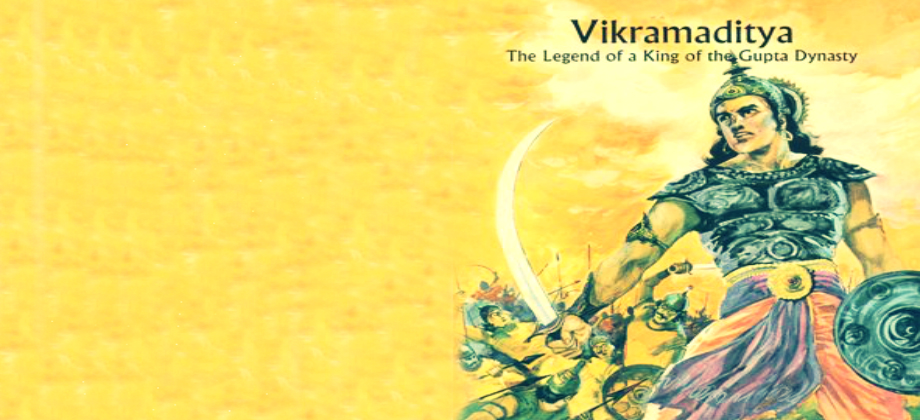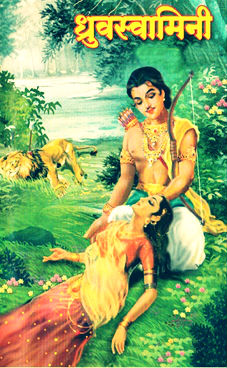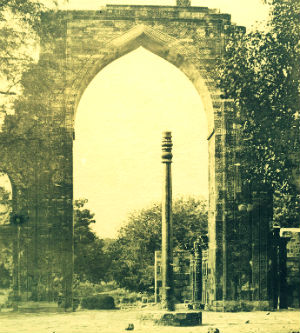 Introduction
Introduction
1. Chandragupta II The Great (चन्द्रगुप्त विक्रमादित्य) was one of the most powerful emperors of the Gupta empire in northern India. His rule spanned c. 380–413/415 CE, during which the Gupta Empire achieved its zenith, art, architecture, and sculpture flourished, and the cultural development of ancient India reached its climax.
2. The period of prominence of the Gupta dynasty is very often referred to as the Golden Age of India.
3. Chandragupta II was the son of the previous ruler, Samudragupta the Great. He attained success by pursuing both a favorable marital alliance and an aggressive expansionist policy in this which his father and grandfather (Chandragupta I) set the precedent.
4. Samudragupta set the stage for the emergence of classical art, which occurred under the rule of Chandragupta II. Chandragupta II gave great support to the arts. Artists were so highly valued under his rule that they were paid for their work — a rare phenomenon in ancient civilizations. This is evidenced by later reports of the presence of a circle of poets known as the Nine Gems in his court. The greatest among them was Kalidasa, who authored numerous immortal pieces of literature including Abhijñānaśākuntalam. The others included Sanskrit grammarian Amara Sinha and the astronomer-mathematician Varahamihira.
5. From 388 to 409 he subjugated Gujarat, the region north of Mumbai, Saurashtra, in western India, and Malwa, with its capital at Ujjain.
6. Fa-hein (337 – c. 422 CE) was the first of three great Chinese pilgrims who visited India from the fifth to the seventh centuries CE, in search of knowledge, manuscripts and relics.
Dhruvaswamini, Vikramaditya's Wife

1. Chandragupta II's mother, Datta Devi, was the chief queen of Samudragupta the Great. After Samudragupta's death his elder son, Ramagupta, took over the throne and married Chandragupta II's fiance Dhruvaswamini by force.
2. king Ramagupta, the elder brother of Chandragupta II, deciding to surrender his queen Dhruvaswamini to the Saka ruler of the Western Kshatrapas Rudrasimha III (r. 388 - 395 CE), after a defeat at the Saka ruler's hands.
3. To avoid the ignominy the Guptas decide to send Madhavasena, a courtesan and a beloved of Chandragupta II, disguised as the queen Dhruvaswamini.
4. Chandragupta II changes the plan and himself goes to Rudrasimha III disguised as the queen. He then assassinates Rudrasimha III and later his brother Ramagupta. Dhruvaswamini is then married to Chandragupta II.
Vikramaditya's Conquests
1. Chandragupta Vikramaditya conquered about twenty one kingdoms, both in and outside India.
2. After finishing his campaign in the East and West India, Vikramaditya (Chandra Gupta II) proceeded northwards, subjugated the Parasikas (Persians), then the Hunas and the Kambojas tribes located in the west and east Oxus valleys respectively.
3. Thereafter, the king proceeds across the Himalaya and reduced the Kinnaras, Kiratas etc. and lands into India proper.
4. The Brihatkathamanjari of the Kashmiri writer Kshmendra states, king Vikramaditya (Chandra Gupta II) had "unburdened the sacred earth of the Barbarians like the Sakas, Mlecchas, Kambojas, Yavanas, Tusharas, Parasikas, Hunas, etc. by annihilating these sinful Mlecchas completely"
Vikramaditya's Legacy

1. Vikram-Samvat calendar starts from 57 BCE. The Hindu Vikram-Samvat calendar is celebrated as New Year's Day. In Nepal, Vikram Sambat is the official calendar.
2. Close to the Qutub Minar is one of Delhi's most curious structures, an iron pillar, dating back to 4th century CE. The pillar had been put up by Chandragupta II himself after defeating Vahilakas. And after this great feat, he put up this pillar as a memory of the victory. The pillar also highlights ancient India's achievements in metallurgy. The pillar is made of 98% wrought iron and has stood more than 1,600 years without rusting or decomposing. This iron pillar is similar to the pillars of ashoka.
Comments
comments
 Introduction
1. Chandragupta II The Great (चन्द्रगुप्त विक्रमादित्य) was one of the most powerful emperors of the Gupta empire in northern India. His rule spanned c. 380–413/415 CE, during which the Gupta Empire achieved its zenith, art, architecture, and sculpture flourished, and the cultural development of ancient India reached its climax.
2. The period of prominence of the Gupta dynasty is very often referred to as the Golden Age of India.
3. Chandragupta II was the son of the previous ruler, Samudragupta the Great. He attained success by pursuing both a favorable marital alliance and an aggressive expansionist policy in this which his father and grandfather (Chandragupta I) set the precedent.
4. Samudragupta set the stage for the emergence of classical art, which occurred under the rule of Chandragupta II. Chandragupta II gave great support to the arts. Artists were so highly valued under his rule that they were paid for their work — a rare phenomenon in ancient civilizations. This is evidenced by later reports of the presence of a circle of poets known as the Nine Gems in his court. The greatest among them was Kalidasa, who authored numerous immortal pieces of literature including Abhijñānaśākuntalam. The others included Sanskrit grammarian Amara Sinha and the astronomer-mathematician Varahamihira.
5. From 388 to 409 he subjugated Gujarat, the region north of Mumbai, Saurashtra, in western India, and Malwa, with its capital at Ujjain.
6. Fa-hein (337 – c. 422 CE) was the first of three great Chinese pilgrims who visited India from the fifth to the seventh centuries CE, in search of knowledge, manuscripts and relics.
Dhruvaswamini, Vikramaditya's Wife
Introduction
1. Chandragupta II The Great (चन्द्रगुप्त विक्रमादित्य) was one of the most powerful emperors of the Gupta empire in northern India. His rule spanned c. 380–413/415 CE, during which the Gupta Empire achieved its zenith, art, architecture, and sculpture flourished, and the cultural development of ancient India reached its climax.
2. The period of prominence of the Gupta dynasty is very often referred to as the Golden Age of India.
3. Chandragupta II was the son of the previous ruler, Samudragupta the Great. He attained success by pursuing both a favorable marital alliance and an aggressive expansionist policy in this which his father and grandfather (Chandragupta I) set the precedent.
4. Samudragupta set the stage for the emergence of classical art, which occurred under the rule of Chandragupta II. Chandragupta II gave great support to the arts. Artists were so highly valued under his rule that they were paid for their work — a rare phenomenon in ancient civilizations. This is evidenced by later reports of the presence of a circle of poets known as the Nine Gems in his court. The greatest among them was Kalidasa, who authored numerous immortal pieces of literature including Abhijñānaśākuntalam. The others included Sanskrit grammarian Amara Sinha and the astronomer-mathematician Varahamihira.
5. From 388 to 409 he subjugated Gujarat, the region north of Mumbai, Saurashtra, in western India, and Malwa, with its capital at Ujjain.
6. Fa-hein (337 – c. 422 CE) was the first of three great Chinese pilgrims who visited India from the fifth to the seventh centuries CE, in search of knowledge, manuscripts and relics.
Dhruvaswamini, Vikramaditya's Wife
 1. Chandragupta II's mother, Datta Devi, was the chief queen of Samudragupta the Great. After Samudragupta's death his elder son, Ramagupta, took over the throne and married Chandragupta II's fiance Dhruvaswamini by force.
2. king Ramagupta, the elder brother of Chandragupta II, deciding to surrender his queen Dhruvaswamini to the Saka ruler of the Western Kshatrapas Rudrasimha III (r. 388 - 395 CE), after a defeat at the Saka ruler's hands.
3. To avoid the ignominy the Guptas decide to send Madhavasena, a courtesan and a beloved of Chandragupta II, disguised as the queen Dhruvaswamini.
4. Chandragupta II changes the plan and himself goes to Rudrasimha III disguised as the queen. He then assassinates Rudrasimha III and later his brother Ramagupta. Dhruvaswamini is then married to Chandragupta II.
Vikramaditya's Conquests
1. Chandragupta Vikramaditya conquered about twenty one kingdoms, both in and outside India.
2. After finishing his campaign in the East and West India, Vikramaditya (Chandra Gupta II) proceeded northwards, subjugated the Parasikas (Persians), then the Hunas and the Kambojas tribes located in the west and east Oxus valleys respectively.
3. Thereafter, the king proceeds across the Himalaya and reduced the Kinnaras, Kiratas etc. and lands into India proper.
4. The Brihatkathamanjari of the Kashmiri writer Kshmendra states, king Vikramaditya (Chandra Gupta II) had "unburdened the sacred earth of the Barbarians like the Sakas, Mlecchas, Kambojas, Yavanas, Tusharas, Parasikas, Hunas, etc. by annihilating these sinful Mlecchas completely"
Vikramaditya's Legacy
1. Chandragupta II's mother, Datta Devi, was the chief queen of Samudragupta the Great. After Samudragupta's death his elder son, Ramagupta, took over the throne and married Chandragupta II's fiance Dhruvaswamini by force.
2. king Ramagupta, the elder brother of Chandragupta II, deciding to surrender his queen Dhruvaswamini to the Saka ruler of the Western Kshatrapas Rudrasimha III (r. 388 - 395 CE), after a defeat at the Saka ruler's hands.
3. To avoid the ignominy the Guptas decide to send Madhavasena, a courtesan and a beloved of Chandragupta II, disguised as the queen Dhruvaswamini.
4. Chandragupta II changes the plan and himself goes to Rudrasimha III disguised as the queen. He then assassinates Rudrasimha III and later his brother Ramagupta. Dhruvaswamini is then married to Chandragupta II.
Vikramaditya's Conquests
1. Chandragupta Vikramaditya conquered about twenty one kingdoms, both in and outside India.
2. After finishing his campaign in the East and West India, Vikramaditya (Chandra Gupta II) proceeded northwards, subjugated the Parasikas (Persians), then the Hunas and the Kambojas tribes located in the west and east Oxus valleys respectively.
3. Thereafter, the king proceeds across the Himalaya and reduced the Kinnaras, Kiratas etc. and lands into India proper.
4. The Brihatkathamanjari of the Kashmiri writer Kshmendra states, king Vikramaditya (Chandra Gupta II) had "unburdened the sacred earth of the Barbarians like the Sakas, Mlecchas, Kambojas, Yavanas, Tusharas, Parasikas, Hunas, etc. by annihilating these sinful Mlecchas completely"
Vikramaditya's Legacy
 1. Vikram-Samvat calendar starts from 57 BCE. The Hindu Vikram-Samvat calendar is celebrated as New Year's Day. In Nepal, Vikram Sambat is the official calendar.
2. Close to the Qutub Minar is one of Delhi's most curious structures, an iron pillar, dating back to 4th century CE. The pillar had been put up by Chandragupta II himself after defeating Vahilakas. And after this great feat, he put up this pillar as a memory of the victory. The pillar also highlights ancient India's achievements in metallurgy. The pillar is made of 98% wrought iron and has stood more than 1,600 years without rusting or decomposing. This iron pillar is similar to the pillars of ashoka.
1. Vikram-Samvat calendar starts from 57 BCE. The Hindu Vikram-Samvat calendar is celebrated as New Year's Day. In Nepal, Vikram Sambat is the official calendar.
2. Close to the Qutub Minar is one of Delhi's most curious structures, an iron pillar, dating back to 4th century CE. The pillar had been put up by Chandragupta II himself after defeating Vahilakas. And after this great feat, he put up this pillar as a memory of the victory. The pillar also highlights ancient India's achievements in metallurgy. The pillar is made of 98% wrought iron and has stood more than 1,600 years without rusting or decomposing. This iron pillar is similar to the pillars of ashoka.

